On the machine where you have the FTP server running, browse https://canyouseeme.org/
In the "Port to check" field type in 21 and click on "Check Port". Is it able to connect? Does it show your IP address to be "xx.59.xxx.xxx"? If it's able to connect, then that is the IP address that you need to use when connecting over the internet.
On my home network, my router assigns IP addresses in the 192.168.1.nnn range. It also manages DNS so that name resolution works. Some routers don't do that, or some users choose to use Google DNS (8.8.8.8) so they may need to verify that Windows Network Discovery is working.
If your client machines can resolve the server name, then you can use network shares as you pointed out, \XXXXX-FS\Sharename.
If name resolution doesn't work but you know that you are on your private network, then you can use the local IP address. That would be your equivalent of my 192.168.1.nnn. Run ipconfig.exe from a command prompt on the server to get it's IP address.
When you connect over the internet via FTP, you need to use passive mode due to the way that FTP initiates the connections.
https://slacksite.com/other/ftp.html
If you are having connection problems, then open a command prompt and test with ftp.exe. Use commands like "open xx.59.xxx.xxx" to connect. In the FTP server config, you can add a welcome message so that you can verify that you are accessing your server.
You should note that FTP is not a secure protocol, so be aware of that when transferring data over the internet. In general, I would recommend installing the OpenSSH feature of Windows and use encrypted SFTP for internet transfers.
Hope that helps you.


